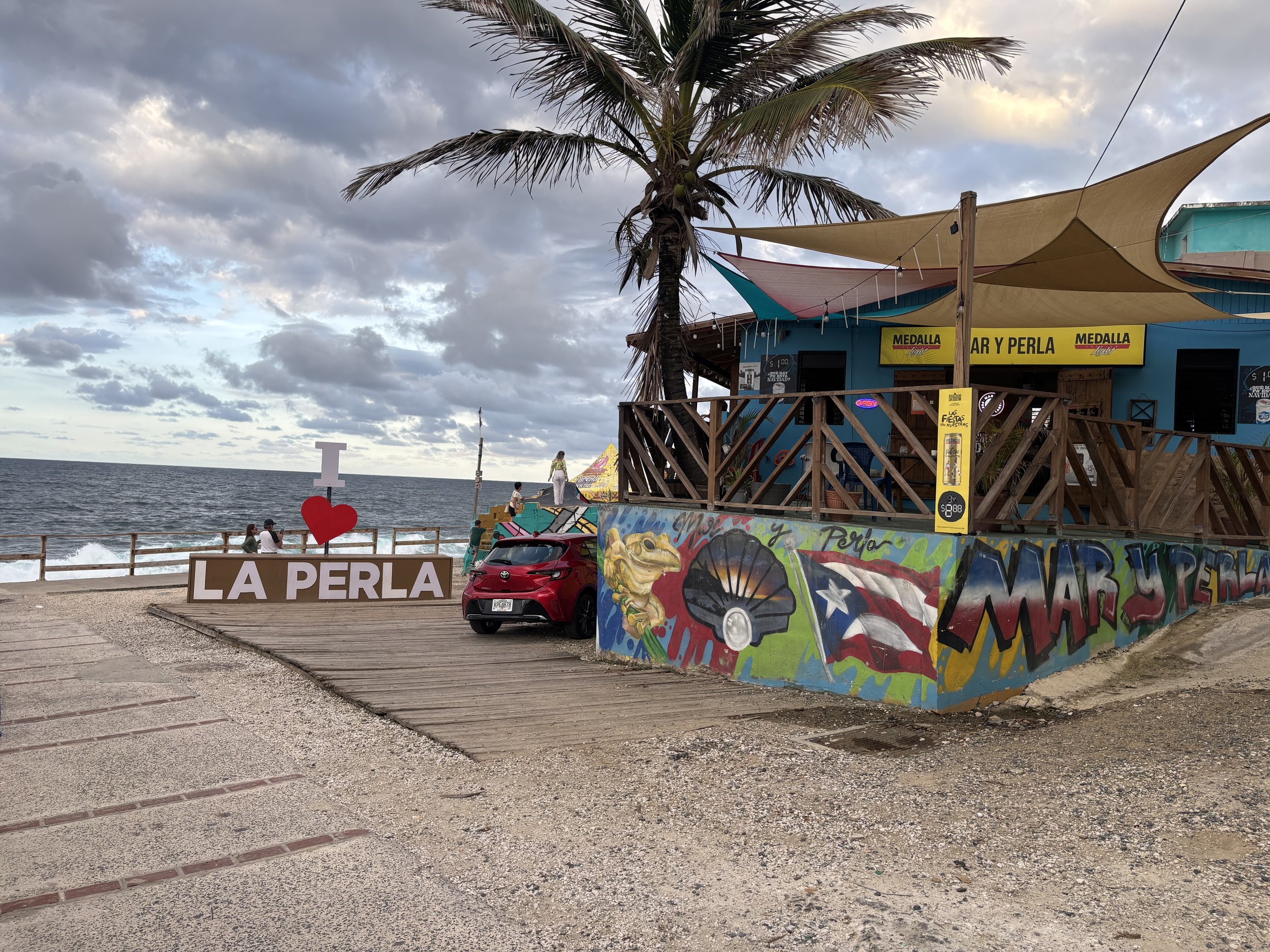La Perla | Puerto Rico
A Man Paints in Old San Juan
"Welcome to the oldest colony."
That's what the graffiti on the walls of La Perla shouts, loudly, silently, and somehow ironically.
I might have seen this message before, but honestly, my sweaty, half-delirious, mid-afternoon runs from Santurce to Old San Juan and back never allowed for much philosophical reflection. My brain was usually too busy negotiating terms of surrender with the oppressive heat and humidity. Turns out, real San Juanians don’t torture themselves with mid-day jogs; they’re smarter, running just before sunset (or early in the morning), when the Caribbean breeze finally takes pity and whispers softly enough to let your mind wander.
La Perla viewed from Castillo San Felipe del Morro
It was during one of those blissful sunset runs, veering off the sterilized, postcard-perfect tourist paths, that I stumbled into La Perla, a settlement born out of necessity. La Perla began in the 18th century as the designated site for slaughterhouses because, by law, all things unsavory had to be kept outside the protective city walls. Enslaved people, too, were forced to build their homes there, beyond the safety and snobbery of Old San Juan’s fortified edges.
La Perla sits literally on the edge, beneath the fortified walls of Old San Juan, clinging precariously to the cliffs.
If you've ever watched Parasite, one of my favorite movies, you’ll know the imagery: the wealthy perched high above, untouched by floods, sewage, or reality; the poor clustered below, first to bear the weight of every disaster. That’s La Perla's paradox: stunningly colorful yet battered by storms, vibrant yet neglected. Forgotten yet impossible to ignore.
Painted Puerto Rican Flag on a Building in La Perla
Though tiny (I could have run every street of La Perla in less than fifteen minutes, if I wasn’t so busy gaping at everything), the place holds the full, tangled story of Puerto Rico. As my feet hit La Perla’s uneven, cracked roads, graffiti surrounded me, louder than any history book.
"Why are walls so dangerous?" one mural demanded, answering itself: "Because walls speak when justice is silent, and the media lies."
Another marked the grim legacy of Hurricane Maria: "We record our dead: 4645."
And scrawled across several corners, the same antagonist kept appearing: "PROMESA is poverty!", a nod to the U.S.-imposed austerity measures that continue to strangle Puerto Rico’s economy.
These murals told a story fierce in its honesty, about colonialism, disenfranchisement, economic asphyxiation. Puerto Rico has been a U.S. territory, (whatever that means) since Spain handed it over in 1898. Puerto Ricans got citizenship in 1917 but no real vote or voice in Congress, like getting invited to dinner but told to sit silently and watch others eat. Today, the island hangs in limbo: some demanding statehood, some craving independence, and some unsure what freedom even means anymore. PROMESA, the controversial 2016 fiscal control board, further tightened this grip, imposing harsh cuts to education, healthcare, pensions, and public services. La Perla’s murals represent the fight against all of it, capturing a truth too raw for tourist brochures.
La Perla by the Water
As I ran deeper into La Perla, expecting danger lurking in every shadow (thank you, well-meaning strangers, for that paranoia), what I found instead was life.
Music poured from open doorways and bars, loud, vibrant, welcoming.
Near El Bowl, an old skating spot that transforms into a community pool on weekends, a crowd had gathered around three local drummers pounding out the urgent, joyful rhythms of Puerto Rico. Wanting to soak it all in, I slowed to a walk.
La Perla Alleys
They say La Perla was once dangerous, violent.
Maybe, if you only judge a place by its peeling paint, cramped spaces, and strewn trash, you could convince yourself that’s still true.
But I saw something else: a hidden enclave, battered but breathing, colorful and alive, a future Santorini, waiting for a world brave enough to believe in it.
Colorful La Perla
As I turned back toward Santurce, my legs tired but my heart wide awake, I thought about those murals. Those walls. That fierce defiance painted in broad strokes against a colonial sky. And naturally, because every good run deserves a great reward, I made my way to La Alcapurria Quema in La Placita de Santurce, founded by freed Black slaves, where the history continues in every bite of crispy Alcapurrias and every mouthful of Majado de Viandas (mashed yams and taro root).






